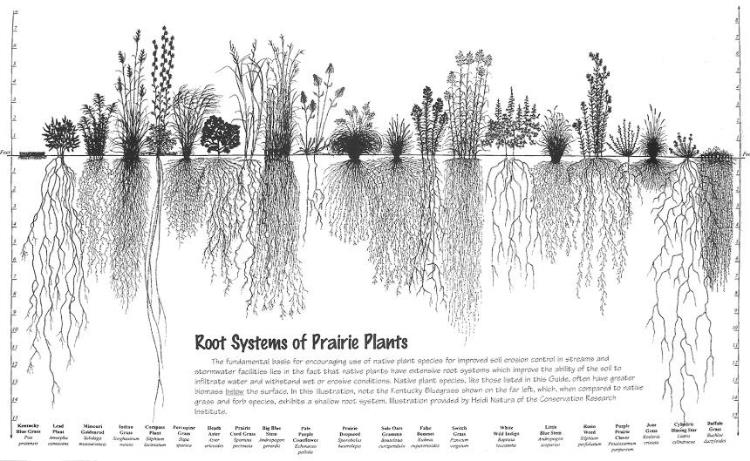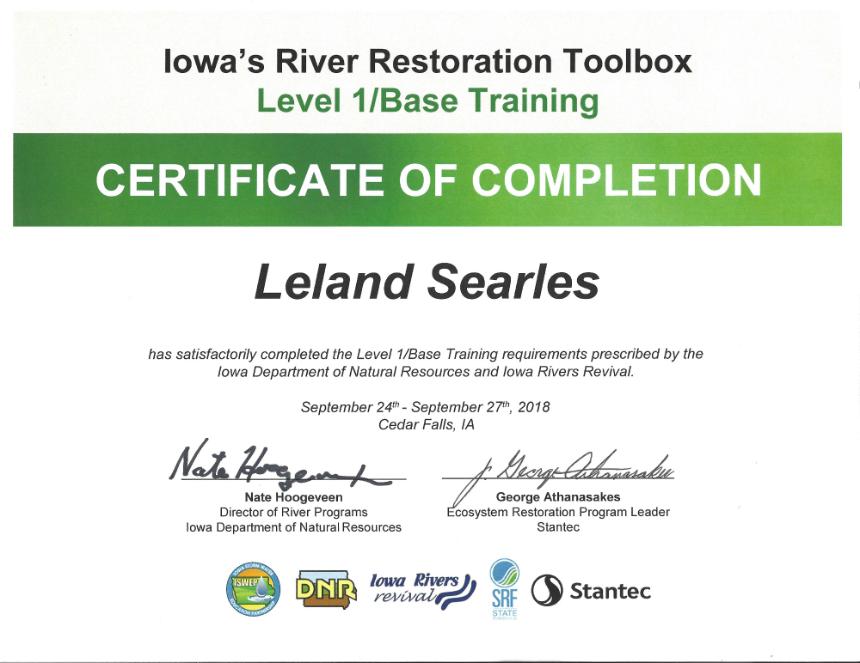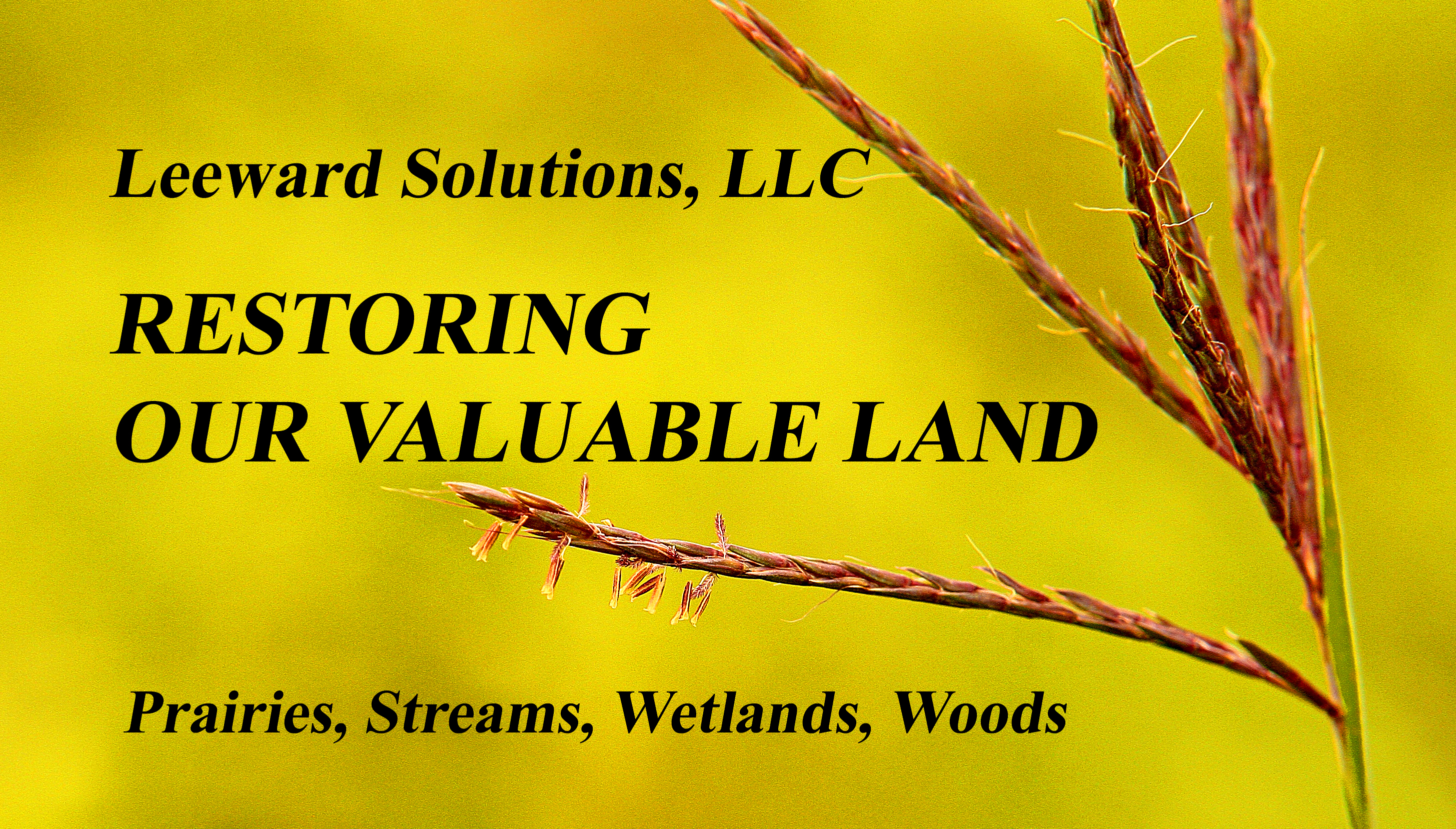The highly regarded ecologist Aldo Leopold said that "intelligent tinkering" with nature required that the tinkerers keep all the parts. While we are missing many parts now, we can still put ecosystems back together in much the way they were and restore the valuable ecological and economic services they provided.
Skip down the page to your topic of interest by clicking on a link:
Ecosystem Restoration & Management
Ecosystem restoration is a catch-all phrase for recreating and maintaining several different
types of ecosystems. The ecosystems are those of the Upper Midwest, especially in
Iowa: tallgrass and mid-grass prairies, savanna, wetlands (about seven kinds in Iowa),
and woodlands (Iowa has about nine different types). Methods vary widely, depending on
the goals and size of the project.
An effective project begins with general goals, planning steps that identify
resources, equipment, and personnel needs, and outcome-based criteria to ascertain
success. Here a few types of projects are outlined for your benefit. Questions can be
directed through the Contact Leeward page for a quick reply.
Restoration projects identification of native animal and plant resources (1) on the site that
can be enhanced, and (2) resources in the area that can be accessed for the gene pool that
likely existed at the site. Projects may involve minor to extensive modification of a
site to remove exotics (nonnative species), change hydrological conditions, filter nutrients
and pollutants, alter surface water flows, create habitat for aquatic and land wildlife, and
achieve other goals.
Leeward Solutions offers.
Stream Morphological Evaluation
The characteristics of the channel, banks, valley, water flow, and more are necessary for stream modification and
restoration work. Leeward Solutions, LLC, offers field data collection of quantitative measures for reference streams and
stream restorationprojects. A successful project imitates the natural stream processes based on channel size, stream order,
floodplain, discharge at different flow levels, and vegetation.
Typically, morphological evaluation determines:
 resize.jpg?timestamp=1440973267714)
- stream velocity at different flow levels.
- discharge rate.
- the present bankfull level, the level of highest efficiency of sediment transport.
- flood-prone area (the area between a return interval of about 1.5 and 50 years.
- shear stresses and other forces that may cause unusual rates of erosion or sedimentation.
Without an understanding of these in existing streams and as
measurable goals for a restoration, the risk of a costly failure
is much higher.
The photo shows a very narrow (2-3 inches) stream through
beach sand that formed after a rain. Even at this small scale, the
channel displays nearly all the features of a much larger stream.
Gardening with Native Plants
Many
people who see a profile of the root depths of native prairie plants
come away with an enduring image of the
soil-holding and
topsoil-developing potential of these plants. That image appears below. (Notice that Kentucky bluegrass,
a common choice for lawns, appears at the far left for comparison.)
There are
several advantages to using native plants as garden plants. Many species
offer the season-by-season color and
variation in height that nonnative
plants do. Because they are native, they are far less likely to escape
and become
problematic weeds. Think of what has happened with garlic mustard, dandelions, brome grass, and many others.

difficulty. Many are tolerant of both high- and low-precipitation seasons, because that is a primary feature of our climate.
Many are perennial, so they lend themselves to beds of self-reproducing color and texture. If you have a large backyard or
larger area to convert to a prairie-like habitat, a few years of work often results in an area of constant change and
discovery that requires very little mowing. Suburban and urban lawns often lack much topsoil depth; a prairie area begins
at once to send down roots and create the organic layer, thus rebuilding the topsoil.
The main disadvantage of a prairie restoration is that it can be very labor intensive for a few years. If the
careful use of
fire is not possible, occasional mowing helps maintain
plant diversity and controls many of the nonnative weeds. Some
use of
herbicides may be needed for the more pernicious and pervasive weeds.
However, the selective use of native
plants in flower beds is far less
likely to impose these disadvantages on you, as it is much more like everyday gardening.
The main differences happen below the surface, once the plants are growing.
Leeward Solutions offers consulting in the planning, implementation, and follow-up steps,
including layout, plant selection, seeding and seed sources, management of plantings, and
follow-up on your developing garden or restoration.
the Reader (at no cost) by clicking here for Windows operating systems or here for Macintosh systems. Once the Reader download
has saved on your local drive, you will need to install it, so make a note about the folder(s) in which the download file is
saved.

|
Native Plant Gardening Handout 6per.pdf Size : 10585.128 Kb Type : pdf |
Plant Inventories
Botanical or floristic inventories have a wide variety of uses and about as many methods of data collection and management. The choice of method depends on the goal of the inventory.
A simple inventory list may be preferred, and the person conducting the inventory will need familiarity with nearly all the species that could appear across a number of ecosystems and plant communities. Often the quality of a particular ecosystem, such as tallgrass prairie, is best demonstrated by "conservative" species, the plants that are most likely to suffer from disturbances. These are also the species that are less familiar because they are not dominant members of that plant community and/or because they are easily overlooked. A good field botanist needs to recognize these or, at the very least, be able to place an unidentified species in a larger taxonomic group and use botanical keys and laboratory equipment to complete the identification.
Inventories should include at least three visits during different seasons. In the Midwest, many plants bloom according to a cool-season or warm-season "schedule." Cool-season plants appear in early to mid-spring and flower from late March to June. Seed production begins anytime from April to mid-summer. Some of these plants have almost no trace on the surface by June, because they die back to dormancy. In contrast, warm-season plants, including many well-known prairie species, may exist as green growth through early to mid-summer, with flowering occurring in late summer to autumn and seed production thereafter. For example, an April inventory may completely miss many warm-season forbs and grasses that have barely sprouted or grown shoots. It is necessary to recognize seedlings and young plants from their overall growth pattern ("aspect") and botanical features.
Beyond listing, mapping of ecosystem remnants or restoration efforts may be a goal. Mapping enhances a project in which preservation and expansion of an existing area of native plants are desireable. Good field notes (with or without technology such as a lightweight laptop and premade plant list files) and proper equipment, such as GPS (Global Positioning Systems), are very useful. Boundaries between communities and areas in which different communities intergrade are of interest, and their correspondence to other physical features, such as historical records, soils, and topography may be of interest. Further, if seed collection for restoration of other areas is one goal, fairly good mapping can help the collectors with relocating a patch of a given species during peak seed production.
Statistical methods for assessing the quality of a plant community carry the analysis even further. These start with detailed inventories and, in the best of worlds, mapping, followed by the assignment of a Coefficient of Conservatism to each species. The Coefficient comes from a list that has been drawn up and agreed upon by botanists, and it usually covers an entire state or ecological region. The coefficients are then added and the Floristic Quality Index (FQI) is determined through a mathematical equation. The FQI is a quantitative, shorthand means of stating the quality of a given location from the proportion of conservative (uncommon and/or specialized), generalist (and usually common and hardy), and exotic (nonnative) species.
For preservation and restoration work, a high quality result is optimal. However, such remnant areas are rare in Iowa and the Upper Midwest Corn Belt. More likely a remnant area has degraded over time so that only the most tolerant species are left, or natives are well mixed with nonnative species. Interseeding and prescribed burning or mowing may work well, in order to avoid disturbance of the existing native plants. However, if very few or no native species exist at the site, the process must start from scratch. It's best to use local ecotype seed that has been gathered from remnants within 50 to 100 miles and is already adapted to conditions at the restoration site.
Otherwise, seed from a regional supplier is a last resort, in hopes that several years of management will result in a genetic base similar to the native local species.
Except for an area that already is a high-quality remnant, the change in the FQI or other numerical expression of quality over time is more important than a quality measure at one point in time. Restoration, whether through enhancement of an existing plant community or beginning from nothing, is a multi-year process.

